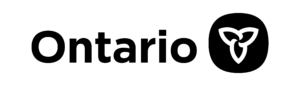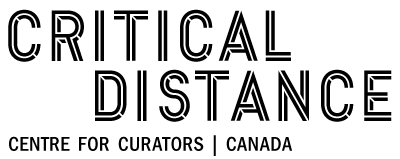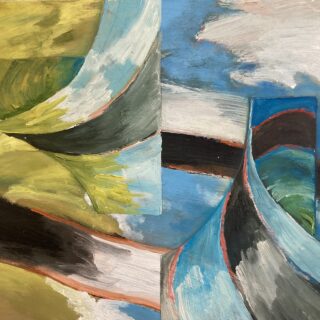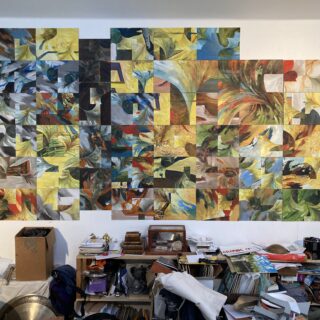EXHIBITION: The Contingent Image: John Climenhage with Critical Distance
September 20, 2025 - November 15, 2025Artist: John Climenhage
Curator: CDCC Director, Shani K Parsons
On view September 20 — November 15, 2025
Opening Saturday, 9/20 in conjunction with Ontario Culture Days at 401 Richmond, RSVP for the Hands-on Curatorial Workshop
Critical Distance Centre for Curators (CDCC) is pleased to present The Contingent Image, an artistic and curatorial collaboration and exhibition-as-research developed by Peterborough-based artist John Climenhage in conversation with CDCC Director Shani Khoo Parsons. Featuring an expansive new body of work that Climenhage has been developing since 2015, The Contingent Image is the artist’s first solo exhibition in Toronto in over 20 years.
The Contingent Image comprises three large-scale wall-based assemblages of 170+ paintings selected from a series of over 250 panels. Following a decisive moment of artistic reckoning during which Climenhage destroyed a number of his own past works, the artist has painstakingly reworked, and later began piecing together, a new way to make painting out of this proverbial wreckage. Proliferating across the walls to encompass the viewer, the assemblages evoke the art historical sublime in their sheer scale and striking visuality. Yet this work was never intended as a grand gesture but rather has slowly accumulated through an intimate and ongoing process of search, recovery, and reflection in the wake of grief—and not just for that momentary lapse of faith in art, but as it became compounded by deep personal loss (the still-unsolved killing of close friend and long-time artistic collaborator Jeremy Gordaneer in 2021), and broader disheartenment at humanity’s capacity for destruction—at both individual and international scales. As such, The Contingent Image marks a moment of desire, akin to that of Walter Benjamin’s Angel of History, “to awaken the dead and to piece together what has been smashed.” Against the storm that drives us “irresistibly into the future … while the rubble-heap [of catastrophe] … grows sky-high,” 1 The Contingent Image synthesizes a lifetime of memory (the tragic, the magic, as well as the mundane), of observation and practice in painting, of relationships and conversations in the arts and beyond, of an enduring concern with issues of geopolitical import, and of a hard-won and finely-honed intuition—evincing a critical approach to improvisation that has become second nature to an artist who has not only painted for over 30 years but has also been a practicing musician for a decade longer.
As an exhibition-as-research, The Contingent Image is an invitation to visitors to participate through the making of their own unique assemblages on a large table in the gallery space using a selection of Climenhage’s original works set aside for this purpose. In conversations that arise through this hands-on opportunity, visitors can gain insight not only into Climenhage’s artistic processes in relation to contemporary painting and abstraction—they can experience for themselves, firsthand, a sense of how “painters go through a catastrophe, or through a conflagration, and leave the trace of this passage on the canvas, as of the leap that leads them from chaos to composition.” 2 With each ‘refresh,’ other images and ideas will rise to the surface as visual and conceptual associations between shapes, colours, lines, volumes, and voids are dissolved and reconstituted anew.
Seen as a contingent thing, the image is no longer assumed to be final or fixed. Meaning, likewise, becomes mutable—mutual. As such, the key question relevant to this artwork and process is not: “is it true? But: does it work? What new thoughts does it make it possible to think? What new emotions does it make it possible to feel? What new sensations and perceptions does it open in the body?” 3 The Contingent Image is thus offered as an opportunity to explore both aesthetic and socio-political potentials for abstraction in painting in a deeply personal yet participatory way—a chance for connection against current tides toward atomization and isolationism. Perhaps the turbulent, warped, and ‘strange’ spaces in this work will spark feelings of mystification, overwhelm, anxiety—even fear for some—much as the unknown does for so many among us. And yet—perhaps there will also be a willing embrace of this uncertainty, and a sense of wonder, optimism, and joy at the desire to know, both differently and more. Time, and The Contingent Image, will tell.
Notes:
1 Quoted from Walter Benjamin’s “On the Concept of History” (1940).
2 Quoted from “From Chaos to the Brain” in What is Philosophy? (1991) by Gilles Deleuze and Felix Guattari.
3 Questions formulated by Canadian philosopher Brian Massumi in his Translator’s Note for A Thousand Plateaus (1987) by Deleuze and Guattari.
An exhibition catalogue with curatorial essay by Shani K Parsons is forthcoming. Subscribe to our newsletter or follow us on IG for updates. Later this season, The Contingent Image will be extended to Critical Distance’s 8 x 8 ft Billboard at 180 Shaw St. As a virtual mirror of the ever-changing table in the gallery, the Billboard will feature an evolving contingent of images that arise serendipitously over the course of the exhibition run.
The Contingent Image is presented as part of Critical Distance’s Study Hall initiative, space, and series of research and process-oriented programs focused on new modes of critical co-learning and connection-making between curators, artists, artworks, environments, audiences, and ideas.
Critical Distance would like to acknowledge funding support from the Ontario Arts Council, an agency of the Government of Ontario.
![]()

Image: John Climenhage, The Contingent Image, 2025. Oil on panel. Courtesy of the artist.
About the Curator(s)
Shani K Parsons
Since the mid-90s, Shani K Parsons has pursued a multidisciplinary practice focused on exhibition-making — initially through the lenses of architecture, urban planning and public arts administration, then installation, graphic, and environmental design, and most recently through research, writing, curation, and collaboration. She is the Founding Director of Critical Distance Centre for Curators (CDCC).
Find out more

